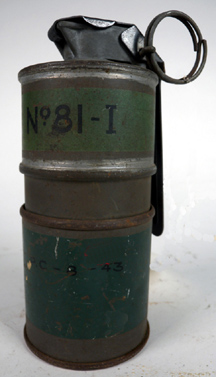The grenade is made up of two parts, a bursting WP section and a smoke emission section. The parts are made of tinplate or blackplate in a cylindrical shape. The upper section is the WP section and is constructed in a similar manner to the No. 80 grenade. It is constructed in three parts, the cylindrical central portion that is seamed and soldered to the other two parts. The top has a roll threaded well in the centre with a detonator tube soldered into the centre of the well. The bottom part has the filling plug soldered into the base. The filler plug has a roll threaded well in the centre to allow attachment of the bottom portion of the grenade. This portion is filled with 5.5 oz. White Phosphorous. The emission portion is also made in three pieces, the cylindrical centre section with a flat base that is seamed onto the centre section. The top is also seamed on and has a roll threaded projection to fit into the bottom of the top portion. This portion is filled with 8.5 oz. HCE compound.
A "Striker Mechanism No. 3 Mk. I or Mk. I/I" screws into the top of the grenade with the "Detonator No. 75 Mk. 2"
The grenade is painted green. The WP section is stencilled with the designation, "PHOS", or a half inch white band, and filling details. The HCE section is also stencilled with the designation, number of the smoke composition (SR269M) and filling details. The base has the manufacturers mark, date of assembly and lot number.
When thrown, the striker mechanism fires the cap in the detonator assembly and ignites the safety fuze. After a delay of 2.5 to 4 seconds the detonator fires and bursts the WP section to provide the instantaneous smoke screen. The flash from the detonator also ignites the HCE section that will emit smoke for approximately 45 seconds.
